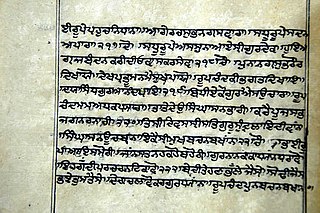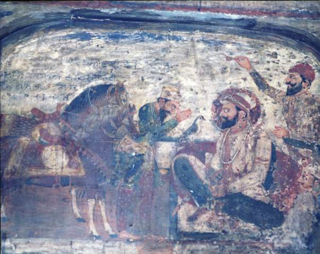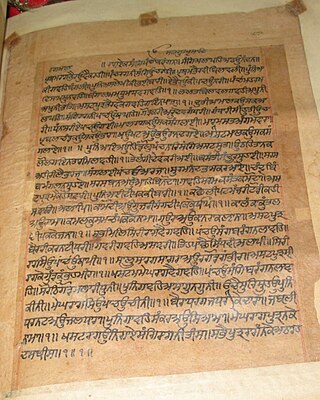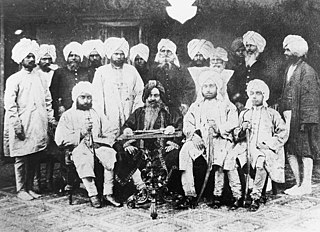
The Guru Granth Sahib is the central holy religious scripture of Sikhism, regarded by Sikhs as the final, sovereign and eternal Guru following the lineage of the ten human gurus of the religion. The Adi Granth, its first rendition, was compiled by the fifth guru, Guru Arjan (1564–1606). Its compilation was completed on 29 August 1604 and first installed inside the Golden Temple in Amritsar on 1 September 1604. Baba Buddha was appointed the first Granthi of the Golden Temple. Shortly afterwards Guru Hargobind added Ramkali Ki Vaar. Later, Guru Gobind Singh, the tenth Sikh guru, added hymns of Guru Tegh Bahadur to the Adi Granth and affirmed the text as his successor. This second rendition became known as the Guru Granth Sahib and is also sometimes referred to as the Adi Granth.

Pratap Singh Giani was a Sikh academic, scholar and calligraphist.

The Seni rebab, also known as the Seniya rabab is a plucked string instrument used in northern India that is said to have been developed by, and to have taken its name from, the notable musician Tansen in the time of the emperor Akbar the Great. It has "a large hook at the back of its head, making it easier for a musician to sling it over the shoulder and play it even while walking." It has been used in Hindustani classical music and religiously, in Sikh music. The rebab influenced the development of the sarod, another Indian musical instrument.

Panj Pyare refers to a gathered ad hoc quintet of five baptised (Amritdhari) Khalsa Sikhs who act as institutionalized leaders for the wider Sikh community.
Dharam Singh, born as Dharam Das, was one of the original Panj Pyare or the Five Beloved, the forerunners of the Khalsa.

Bhai Mani Singh was an 18th-century Sikh scholar and martyr. He was a childhood companion of Guru Gobind Singh and took the vows of Sikhism when the Guru inaugurated the Khalsa in March 1699. Soon after that, the Guru sent him to Amritsar to take charge of Harmandir Sahib, which had been without a custodian since 1696. He took control and steered the course of Sikh destiny at a critical stage in Sikh history. He was also a teacher of the Gianian Bunga, later becoming known as the "Amritsari Taksal", currently located in Sato Ki Gali.

Sikh music, also known as Gurbani Sangeet , and as Gurmat Sangeet, or even as Shabad Kirtan, is the classical music style that is practised within Sikhism. It exists in institutional, popular, and folk traditions, forms, and varieties. Three types of Sikh musicians are rababis, ragis, and dhadhis. Sikh music exists in various melodic modes, musical forms, styles, musicians, and performance contexts.
Daya Singh was one of the Panj Pyare, the first five Sikhs to be initiated into the Khalsa order in 17th-century India. Among the inaugural panj piare quintet, he is traditionally the highest-regarded as he was the first to answer the call for a sacrifice from the guru. Daya Singh was an educated Sikh, with literature being attributed to his authorship.

Suraj Prakash, also called Gurpartāp Sūraj Granth, is a popular and monumental hagiographic text about Sikh Gurus written by Kavi Santokh Singh (1787–1843) and published in 1843 CE. It consists of life legends performed by Sikh Gurus and historic Sikhs such as Baba Banda Bahadur in 51,820 verses. Most modern writing on the Sikh Gurus finds its basis from this text.

Bidhi ChandChhina was a Sikh religious preacher and military commander, from Chhina Bidhi Chand village, 37 kilometers south of Amritsar and Chhina Bidhi Chand was part of Amritsar District not Lahore. His birth place temple is situated in his own village Chhina Bidhi Chand, which was built by the residents with the help of Baba Daya Singh. Baba Daya Singh laid foundation with his own hands. Every year on his birthday Baba Daya Singh, and now Baba Avtar Singh, would go to village Chhina Bidhi Chand and celebrate it there to date. He was a disciple of Guru Arjan and served Guru Hargobind for most of his life.

Kahn Singh Nabha was a Punjabi Sikh scholar, writer, anthologist, lexicographer, and encyclopedist. His most influential work, Mahan Kosh, inspired generations of scholars after him. He also played a role in the Singh Sabha movement.

Ragmala, alternatively spelt as Raagmala or Ragamala is a composition of twelve verses that names various raga. These raga appear in the saroops of Guru Granth Sahib, after the compositions of Guru Arjan entitled Mundavani

Gurū Nānak, also known as Bābā Nānak, was an Indian spiritual teacher, mystic and poet, who is regarded as the founder of Sikhism and is the first of the ten Sikh Gurus.

A Ragi is a Sikh musician who plays hymns (shabads) in different ragas as prescribed in the Sri Guru Granth Sahib.

The Amritsar Singh Sabha was the first faction of reformers of the Singh Sabha movement, founded in 1873, and was one of the major groups who competed to reform and define the Sikh identity in the late 19th century. It was "essentially original and bourgeoisie," and "arose because of a perceived dissolution of the Sikh faith, i.e., Sikhs were believed to be falling into the folds of Hindu thought and practice."

Rababi is a term used to refer to a player of the rabab instrument.

Balvand Rai also spelt as Balwand and Rai Balvand, was a poet mystic and rabab player in the court of Guru Arjan.

The Akal Sena was the Sikh military force established by the sixth Sikh Guru, Guru Hargobind. It was the first standing Sikh army. It was also known as the Akali Dal.

Satta Doom, also spelt as Satta Dum, was a drummer and author of eight verses found within the Guru Granth Sahib.


















